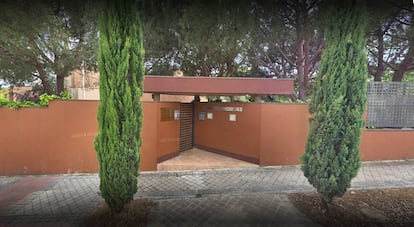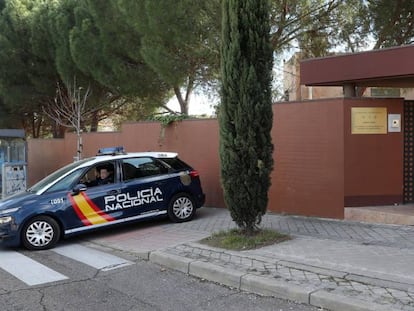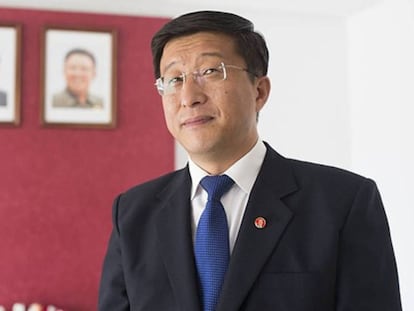Attackers behind assault on North Korean embassy fled to US via Portugal
Spanish judge investigating the strange incident at the diplomatic mission in Madrid has lifted the seal on the probe

The 10 individuals who broke into the North Korean embassy in Madrid on February 22, assaulting personnel and taking computers and cellphones with them, immediately fled to the United States via Portugal, the court investigation shows.
Judge José de la Mata, of Spain’s High Court, Audiencia Nacional, has lifted the seal on an investigation into the mysterious attack against the embassy, which is located in the upscale residential area of Aravaca.
Court papers show that after speeding out of the embassy in luxury vehicles, the attackers broke up into four small groups and traveled to Lisbon, where they boarded an airplane bound for Newark, New Jersey.
The attackers broke up into four small groups and traveled to Lisbon, where they boarded an airplane bound for Newark
Seven of the 10 individuals have been identified, including their alleged leader, a man named Adrian Hong Chang who has Mexican citizenship but is a US resident. Five days after the Madrid incident, this man contacted the FBI to provide information about it.
The court investigation details how the assailants planned the attack, which lasted several hours. After breaking in, the group identified itself to personnel as members of a human rights association working for the liberation of North Korea.
According to the investigating judge, Hong Chang purchased tactical and combat material at a Madrid store ahead of the attack. This material included five fast-draw gun holsters, four combat knives, six H&K replica handguns, a shoulder holster, four pairs of goggles, five tactical flashlights and five different kinds of restraints.
Between February 20 and 22, four other members of the group, among them Ram Lee, a South Korean national, and Sam Ryu, a US citizen, bought additional material at a local hardware store, including shears, 33 rolls of double-sided tape, duct tape, pliers and a telescopic ladder.
Armed with this equipment, at 4.34pm on February 22 the assailants drove to the embassy, where Hong Chang asked to see the commercial attaché, whom he already knew from an earlier visit when he had posed as a businessman.
According to Judge De la Mata, Hong Chang took advantage of a moment of carelessness by embassy personnel to let his accomplices in. The group ran in with machetes, knives, lead bars and replica handguns, and “began violently hitting the occupants, until they were overpowered and immobilized with handcuffs and cable ties.”
Three assailants took the business attaché down to the basement and encouraged him to defect
One of these people was able to jump from the first floor of the building, and despite sustaining injuries from the fall, she ran out of the compound calling for help. A passerby who saw her alerted the police and the health services.
The police established a security perimeter and rang the doorbell of the embassy, where Hong Chang himself opened the door, dressed in a jacket with a lapel pin showing the face of North Korean leader Kim Jong-un. After introducing himself as a high representative of the diplomatic mission, Hong Chang told the officers that nothing unusual was going on, and that if anyone was hurt, the consulate should be immediately contacted.
After spending 60 minutes inside the meeting room, three assailants took the commercial attaché down to the basement and encouraged him to defect. When the latter asserted that he would not, he was again bound and his head covered with a black bag.
The investigation says that embassy personnel were held for several hours, and that the attackers took a couple of pen drives, two computers, two hard drives (one containing security images) and a cellphone.
Most members of the group then drove off in three embassy cars at around 9.40pm. Later, Hong Chang and one other assailant went out the back door and left in another vehicle.
English version by Susana Urra.
Tu suscripción se está usando en otro dispositivo
¿Quieres añadir otro usuario a tu suscripción?
Si continúas leyendo en este dispositivo, no se podrá leer en el otro.
FlechaTu suscripción se está usando en otro dispositivo y solo puedes acceder a EL PAÍS desde un dispositivo a la vez.
Si quieres compartir tu cuenta, cambia tu suscripción a la modalidad Premium, así podrás añadir otro usuario. Cada uno accederá con su propia cuenta de email, lo que os permitirá personalizar vuestra experiencia en EL PAÍS.
¿Tienes una suscripción de empresa? Accede aquí para contratar más cuentas.
En el caso de no saber quién está usando tu cuenta, te recomendamos cambiar tu contraseña aquí.
Si decides continuar compartiendo tu cuenta, este mensaje se mostrará en tu dispositivo y en el de la otra persona que está usando tu cuenta de forma indefinida, afectando a tu experiencia de lectura. Puedes consultar aquí los términos y condiciones de la suscripción digital.
More information
Archived In
Últimas noticias
Half of Scotland is in the hands of 420 property owners
Reinhard Genzel, Nobel laureate in physics: ‘One-minute videos will never give you the truth’
Pinochet’s victims grapple with José Antonio Kast’s rise in Chile
From digital curfews to blocking apps: How technology experts protect their children online
Most viewed
- Pablo Escobar’s hippos: A serious environmental problem, 40 years on
- Reinhard Genzel, Nobel laureate in physics: ‘One-minute videos will never give you the truth’
- Why we lost the habit of sleeping in two segments and how that changed our sense of time
- Charles Dubouloz, mountaineering star, retires at 36 with a farewell tour inspired by Walter Bonatti
- The Florida Keys tourist paradise is besieged by immigration agents: ‘We’ve never seen anything like this’










































